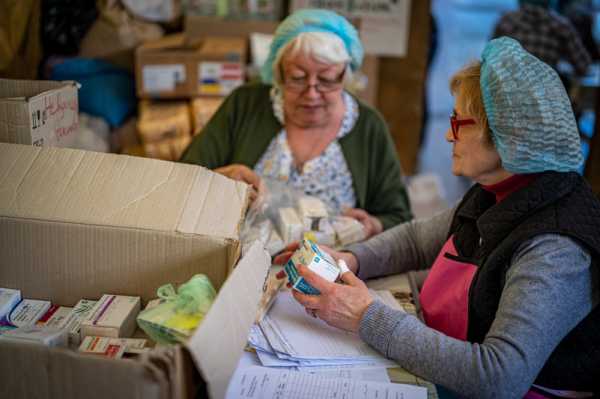
A Caritas Ukraine distribution point for food, water, medicines and other essential goods in the city centre of Ivano-Frankyvsk. In early stage of the war, in 2022, staff and volunteers provided 1,200 meals a day for displaced people (Photo: Mikael Franci/Caritas)
When the humanitarian crisis triggered by the invasion of Ukraine by Russia began in February 2022, two Catholic organisations in Ukraine — Caritas Ukraine and Caritas Spes — could immediately respond to the needs of the millions of people fleeing their homes.
Many sought protection in their safe shelters, often in the basements of local church facilities. Since then, the Caritas organisations in Ukraine have helped over four million people in the war-torn country where only a few humanitarian organisations were operating before the war.
As we face the third winter of war, the situation is still dire. The war grinds on and the role of local organisations has become even more essential for the local communities.
Caritas’ operation in Ukraine is a perfect example of how essential decentralised aid is: the power of local organisations within an international network that can provide support and resources at great scale.
In response to the conflict, the Caritas organisations in Ukraine increased fourfold their staff (almost 3,000 employees today) and managed an exponential increase in the services they provide, also thanks to the vital help of over 7,500 volunteers.
Would a response of this scale have been possible without international support? The answer is, obviously, no.
But the real question is: would the international aid system be as efficient and effective without these national and local organisations who have operated across the country since 1990, employing local experts and remaining close to the communities they serve? Again, the answer is no.
It is because of this experience in Ukraine and in other crises that Caritas can be a lively participant in the international debate around reforming the humanitarian aid sector to decentralise it, localise it and increase the decision-making power of communities affected by, or vulnerable to, crisis in determining what their needs are and how they should be met.
As part of their commitment to recognising and supporting the work of local actors, the European Commission released a guidance note in March on promoting equitable partnerships in humanitarian action.
The document acknowledges the essential role of local humanitarian actors and provides input on how to best channel financial resources and leadership to them. However, the guidance places most of the responsibility on intermediary humanitarian actors located in the EU, as the EU does not fund local actors directly.
The current possibility of transferring funding to local actors is a first step in the right direction, but this is not ideal from an economic and time perspective.
End the ‘starvation cycle’
The example of Ukraine illustrates that donors like the EU should indeed be more ambitious towards localisation of aid. They should enable the approach by directly funding local and national actors. This funding to local actors needs to be predictable, flexible, and longer than the typical one-year funding cycle.
This is needed to reverse the “starvation cycle” of underfunding with multiple intermediaries standing between the donor and local actors, leaving local actors with minimal or no overhead cost coverage and no direct line of communication with the backend donor.
In addition to this, local partners and intermediaries continue to absorb a disproportionate amount of the financial risk arising in complex operational environments, such as currency fluctuations or changes in local regulations and the confiscation of the material aid.
The EU should be willing to absorb a portion of these costs and consider more flexible funding modalities that allow for extension or amendment according to constantly changing situations.
Sign up for EUobserver’s daily newsletter
All the stories we publish, sent at 7.30 AM.
By signing up, you agree to our Terms of Use and Privacy Policy.
They could also dedicate a percentage of funding for the overhead costs of local actors and should closely monitor the roll-out of their guidance note, including through allowing local actors to feedback on the implementation of the guidance.
Finally, the leadership of local actors in coordination mechanisms should be the rule, not the exception, as we highlighted in our new report: “Unfulfilled promises. Addressing the gap between commitments and practice in locally led humanitarian action”.
The work of local humanitarian actors has never been more urgently needed.
Caritas organisations across the world have worked together for decades with no hierarchical structure, and they see clearly how vital a meaningful decentralisation of aid really is, especially if we consider that the demand for humanitarian aid grows every minute.
Therefore, Caritas Europa urges its partners in the humanitarian aid sector, the European Union and other donors to move faster to make the reality match the rhetoric.
Source: euobserver.com



